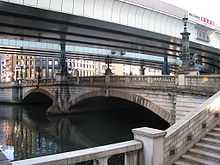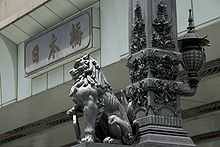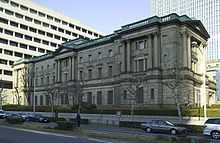Nihonbashi, Tokyo



Nihonbashi (日本橋, literally Japan Bridge), or Nihombashi, is a business district of Chūō, Tokyo, Japan which grew up around the bridge of the same name which has linked two sides of the Nihonbashi River at this site since the 17th century. The first wooden bridge was completed in 1603, and the current bridge made of stone dates from 1911.[1] The district covers a large area to the north and east of the bridge, reaching Akihabara to the north and the Sumida River to the east. Ōtemachi is to the west and Yaesu and Ginza to the south.
History



The Nihonbashi district was a major mercantile center during the Edo period: its early development is largely credited to the Mitsui family, who based their wholesaling business in Nihonbashi and developed Japan's first department store, Mitsukoshi, there. The Edo-era fish market formerly in Nihonbashi was the predecessor of today's Tsukiji fish market. In later years, Nihonbashi emerged as Tokyo's (and Japan's) predominant financial district.
The Nihonbashi bridge first became famous during the 17th century, when it was the eastern terminus of the Nakasendō and the Tōkaidō, roads which ran between Edo and Kyoto. During this time, it was known as Edobashi, or "Edo Bridge." In the Meiji era, the wooden bridge was replaced by a larger stone bridge, which still stands today (a replica of the old bridge has been exhibited at the Edo-Tokyo Museum). It is the point from which Japanese people measure distances: highway signs that report the distance to Tokyo actually state the number of kilometers to Nihonbashi.
Shortly before the 1964 Summer Olympics, an expressway was built over the Nihonbashi bridge, obscuring the classic view of Mount Fuji from the bridge. In recent years, local citizens have petitioned the government to move this expressway underground. This plan was supported by Prime Minister Junichiro Koizumi but opposed by Tokyo Governor Shintaro Ishihara. If implemented, the construction costs are expected to total ¥500 billion (about US$4+ billion).
Places in Nihonbashi


- Bank of Japan
- Mitsukoshi and Takashimaya department stores
- COREDO NIHONBASHI (ja)
- Nihonbashi Mitsui Tower
- Tokyo Stock Exchange
- Kilometre Zero for entire Japan
Companies based in Nihonbashi
Nihonbashi (日本橋)
- Bank of America Merrill Lynch Japan
- HSBC Japan
- Maruzen (丸善)
- Nomura Holdings (野村ホールディングス)
- Takashimaya (高島屋)
- Takeda Pharmaceutical Company has its Tokyo offices in Nihonbashi.[2][3]
- TDK
- Ippon Doll Works
Hakozakicho (箱崎町)
- IBM Japan - IBM Hakozaki Facility
Honcho (本町)
- Daiichi-Sankyo (第一三共)
Muromachi (室町)
- Mitsui Fudosan (Mitsui Group) (三井不動産)
- Mitsukoshi (三越)
- Sembikiya (千疋屋)
- Shinsei Bank (新生銀行)
In the late 1990s GeoCities Japan was headquartered in the Nihonbashi Hakozaki Building in Hakozakicho.[4] At one time Creatures Inc. had its headquarters in the Kawasakiteitoku Building (川崎定徳ビル Kawasakiteitoku Biru) in Nihonbashi.[5]
Railway and subway stations
Subway stations
- Bakuro-yokoyama Station (馬喰横山駅) - Toei Shinjuku Line (S-09)
- Hamachō Station (浜町駅) - Toei Shinjuku Line (S-10)
- Higashi-nihombashi Station (東日本橋駅) - Toei Asakusa Line (A-15)
- Kayabachō Station (茅場町駅) - Tokyo Metro Hibiya Line (H-12), Tokyo Metro Tōzai Line (T-11)
- Kodemmachō Station (小伝馬町駅) - Tokyo Metro Hibiya Line (H-14)
- Mitsukoshimae Station (三越前駅) - Tokyo Metro Ginza Line (G-12), Tokyo Metro Hanzōmon Line (Z-09)
- Nihombashi Station (日本橋駅) - Toei Asakusa Line (A-13), Tokyo Metro Ginza Line (G-11), Tokyo Metro Tōzai Line (T-10)
- Ningyōchō Station (人形町駅) - Toei Asakusa Line (A-14), Tokyo Metro Hibiya Line (H-13)
- Suitengūmae Station (水天宮前駅) - Tokyo Metro Hanzōmon Line (Z-10)
Railway stations
- Bakurochō Station (馬喰町駅) - JR Sōbu Line (Rapid)
- Shin-Nihombashi Station (新日本橋駅) - JR Sōbu Line (Rapid)
Neighboring post towns
As the starting point for the five routes of the Edo period, Nihonbashi provided easy access to many parts throughout ancient Japan.
- Nihonbashi (starting location) - Shinagawa-juku
- Nakasendō (connecting Edo to Kyoto, going through the mountains)
- Nihonbashi (starting location) - Itabashi-juku
- Kōshū Kaidō (connecting Edo to Kai Province (modern-day Yamanashi Prefecture))
- Nihonbashi (starting location) - Naitō Shinjuku
- Ōshū Kaidō (connecting Edo to Mutsu Province (modern-day Fukushima Prefecture))
- Nihonbashi (starting location) - Hakutaku-juku
- Nikkō Kaidō (connecting Edo with Nikkō)
- Nihonbashi (starting location) - Senju-juku
Notes
- ↑ Guide Map/Nihonbashi
- ↑ "FAQ." Takeda Pharmaceutical Company. Retrieved on February 2, 2011. "Q : Where is Takeda located? A : [...] and the Tokyo Head Office is located in Tokyo, Japan."
- ↑ "Overview." Takeda Pharmaceutical Company. Retrieved on February 2, 2011. "Tokyo Head Office 12-10, Nihonbashi 2-chome, Chuo-ku, Tokyo 103-8668"
- ↑ "スタッフ募集." GeoCities Japan. February 21, 1999. Retrieved on April 30, 2009.
- ↑ "Welcome to Creatures Inc." Creatures Inc. Retrieved on October 4, 2010. "東京都中央区日本橋3-2-5川崎定徳ビル別館5F."
External links
| Wikimedia Commons has media related to Nihonbashi, Tokyo. |
| |||||
| |||||
| ||||||||||||||||||||||||||||||||
| ||||||||||||||||||||
Coordinates: 35°41′02″N 139°46′28″E / 35.68389°N 139.77444°E
